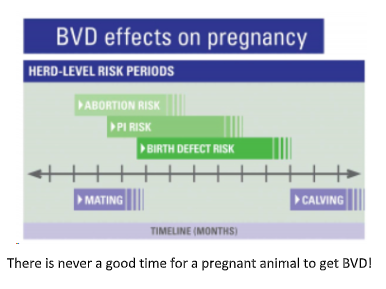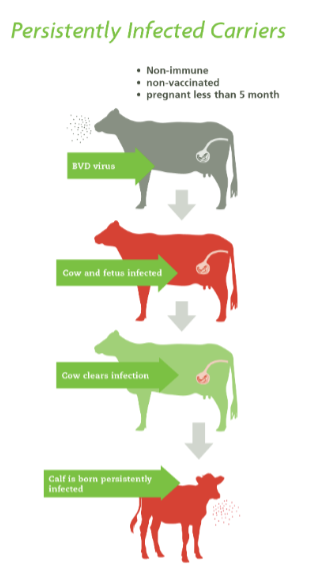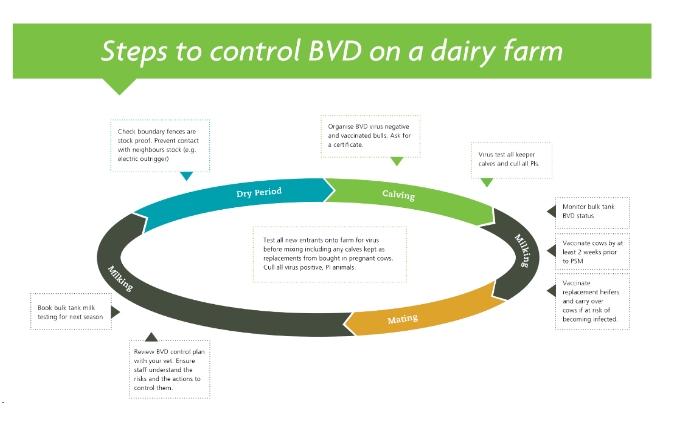Here at NZ Grazing we look after dairy heifer young stock and unfortunately every now and then we end up working with a vet to investigate suspected BVD in a line of heifers.
Whether you are a dairy farmer or a beef farmer BVD management should be on your radar.
In our experience a vet’s recommendation is always:
“If young stock leave your farm gate to go grazing the best protection is to vaccinate against BVD”
So what is BVD? Bovine Viral Diarrhoea also known as BVD is a virus that can circulate between cattle.
Signs of BVD can be quite variable between cattle. The incubation period is about 3-5 days and in non- vaccinated animals can appear as sudden onset of severe sickness with or without bloody diarrhoea, high fever, off-feed, mouth ulcers and often pneumonia, alongside poor weight gain against our NZ Grazing targets making targets difficult to achieve.
BVD can result in;
1. Reproductive wastage (infertility, embryo loss, abortions)
2. Wastage (slow growing calves, deformed and still born calves)
3. Reduced production (reduced milk yield, poor growth rates)
4. Increased disease incidence (mastitis, scouring, pneumonia etc)
BVD is widespread
– 80% of NZ dairy and beef herds have had exposure to BVD
– At any one time 15% of dairy herds have active virus infections
– In a susceptible herd BVD can be a serious costly disease.
BVD Costs
– $70,000 annually for each average sized infected dairy herd ($110-180 per cow).
– Beef farms the cost is around $3000-$9000 per 100 cows on an infected farm or more
than $200/cow.

Persistently Infected (PI) animals
1. A PI continuously sheds the BVD
virus all its life.
2. A PI animal results from infection as
a foetus during the first 4 months of
pregnancy ie they are born a PI –
never created after birth.
3. They are the main source of
infection on farm as they are a virus
factory and spread large amounts of
virus all their life.
4. They have much higher death rates
than non-PI cattle.
5. A PI cow gives birth to a PI calf.
6. Control the PIs and you control the
disease.

Transiently Infected (TI) animals
Most animals that become infected with the BVD virus for the first time develop a transient infection.
1. A transient infection lasts for about 2 weeks followed by a strong immune (antibody) response that lasts for several years.
2. TI is the most frequent infection type in the herd.
3. TI animals may pass the virus on to naïve animals but TIs only shed small amounts of virus for a short period of time.
4. An early pregnant (up to 4 th month of pregnancy) TI cow gives birth to a PI calf.
How does BVD spread?
– PI animals shed millions of viral particles through skin, saliva, nasal secretions, semen, milk, urine faeces etc.
– Direct nose to nose spread is the most common way an animal becomes infected eg mixing of groups or over the fence contact.
– Less commonly via indirect contact eg stock yards, stock trucks, equipment and people.
Controlling BVD
What is your herd BVD status? If you don’t know contact your veterinarian.
Dairy herds can get a bulk milk BVD sample taken (your vet or LIC can organize this)
– High level of antibody – herd infected or has been infected recently
Low to moderate – herd not currently infected with BVD virus and likely hasn’t
been for a few years
Beef farmers are best advised to contact their vet and consider doing surveillance blood tests on 15 or more animals to get a baseline exposure level eg at pregnancy testing. If you don’t look you don’t know.
How can BVD arrive on your farm?
– Inwards cattle – cattle (includes bulls) arriving on farm and their fetuses
– Outgoing and then returning pregnant – off farm grazing eg heifers and carry-over cows
– Over the fence – boundary fences
Action the control plan – remember you want to prevent PI animals on farm
1. TEST incoming animals via ear punch or blood testing (including bulls and calves) cull any PIs. All breeding bulls should have received a BVD test and annual vaccination prior to mating
2. VACCINATE ANNUALLY – cows and heifers to protect during pregnancy and mating bulls
3. IMPLEMENT MANAGEMENT – eg electric outriggers on boundary fences and avoiding nose to nose contact of mobs.

BVD Vaccination
– Vaccination helps prevent transmission of BVD Virus through the placenta to the calf protecting the pregnancy and also preventing a PI calf being born.
– Year round pregnancy protection can be achieved by giving
o Breeding heifers 2 shots of BVD vaccine in their first year of life (as R1s)
o All other cows and heifers an annual booster each year ideally 4 weeks before mating (to ensure maximum protection at the most risk period)
Years ago, NZ authorities could have chosen to eliminate BVD but didn’t. So today we continue to manage BVD on our cattle farms. Don’t believe that you don’t have a BVD issue just because you have never experienced BVD firsthand, it could land on your farm and create havoc – major stresses and costs.
Here at NZ Grazing our contract reared service bulls undergo the highest health protocols available and
include;
- BVD tested
– Annual Vaccinations include BVD, clostridial diseases and leptospirosis
– TB and EBL tested
– BW recorded and a lifetime of NAIT traceability
Rest assured our bulls are fully traceable and are a positive choice in preventing disease entering your farm!
We here at NZ Grazing are actively managing the control of BVD, do you need to review your plans?
We strongly advise you to contact your vet to assist you with keeping BVD out.
Thanks to Kelly Andrews Vets (Te Awamutu) for editing this article.
Data Sources:
BVD Control in Dairy Cattle – BVD Steering Committee Farmer Brochure
BVD Virus – DairyNZ website
BVD Control in Beef Herds – Rural News 22 Oct 2020
